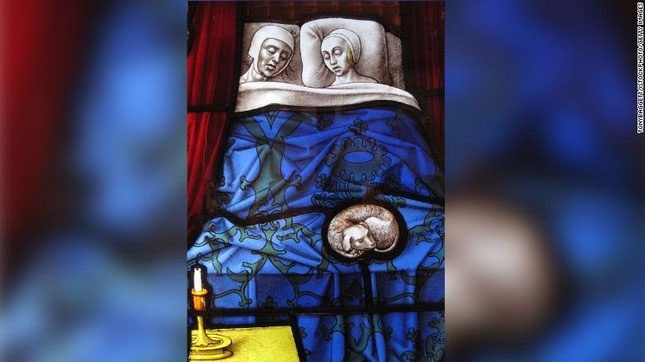Historian A. Roger Ekirch at Virginia Tech, USA, studies ancient sleep and argues that sleep is a biological constant.
However, while researching nightlife in pre-industrial Europe and America, he discovered the first evidence that many people used to sleep in segments – the first sleep and the second sleep, with a break in between for sexual relations, prayer, eating, chatting, and taking medicine.
Ekirch states: “This is a type of sleep that has never been known in the modern world.”
Two-Phase Sleep
Ekirch’s next book, “At Day’s Close: Night in Times Past,” unearthed over 500 references to what has since been called two-phase sleep. He has now found over 2,000 references in dozens of languages, tracing back to ancient Greece. His 2004 book is set to be reissued next April.

Image of a couple sleeping on the stained glass of a church.
Research shows that sleep training for adults prevents depression.
Sleeping through the night did not actually exist until just a few hundred years ago. It only developed with the spread of electric light and the Industrial Revolution, along with the belief that sleep was a waste of time that could be better spent working.
Myths About 8 Hours of Sleep?
The first reference to two-phase sleep that Ekirch found was in a legal document from 1697 from a traveling court called “Assizes” buried in a recording office in London. The account of a 9-year-old girl named Jane Rowth mentions that her mother woke up after her “first sleep” to go outside. The mother was later found dead.
Ekirch then found many references to “first” and “second” sleep in diaries, medical texts, literary works, and prayer books. A guidebook for doctors from 16th-century France advised couples that the best time to conceive was not at the end of a long day but “after the first sleep,” when “they are more inclined” and “make love better.”
Sleeping on the Right Side, Then Turning Left
However, pre-industrial life was not a Halcyon era where our ancestors experienced a day of rest and rejuvenation free from insomnia or other sleep issues, easily synchronizing with the night and day cycles, weather patterns, and seasons, says Sasha Handley, a history professor at the University of Manchester in the UK, who studies how families optimized their sleep in England, Ireland, and British American colonies from 1500 to 1750.
Handley states that her research shows that, like today, sleep was related to physical and mental health and was a topic that caused people anxiety and obsession.
Doctors advised sleepers to lie on their right side first, then turn to their left during the latter half of the night. Lying on the right side, perhaps during the first sleep, was believed to allow food to reach the stomach, where it could be digested. Turning to the left, the cooler side, was said to help with heat distribution throughout the body.
Insomnia
Russell Foster, a professor of biological neuroscience at the University of Oxford, has conducted sleep experiments that show when people have the opportunity to sleep longer, their sleep can become two-phase or even multi-phase.
However, Foster, who is also the director of the Sir Jules Thorn Sleep and Circadian Neuroscience Institute at Oxford, doubts that this is a sleep pattern that can occur for everyone.
He adds that no one should impose a segmented sleep regimen, especially if it reduces total sleep time. Foster notes that interrupted sleep was considered less problematic in the past, but getting a solid 8 hours of sleep in modern times is not always beneficial.
Foster’s research indicates that if we wake up at night, sleep is likely to return, provided it is not disrupted by social media or other behaviors that keep you more alert or trigger a stress response.
Sleep experts recommend that you should get out of bed if you cannot fall back asleep and engage in a relaxing activity in low light.


















































